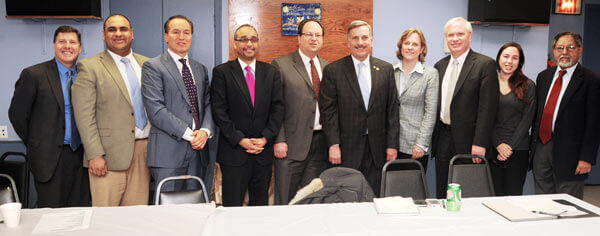By Joe Anuta
The borough president’s job is not clearly defined in the City Charter, which has led the seven Democrats vying for the spot to mold their own ideal of how Queens should be run.
State Sen. Tony Avella (D-Bayside), businessman Everly Brown, City Councilman Leroy Comrie (D-St. Albans), Director of Community Boards Barry Grodenchik, former state Assemblywoman Melinda Katz, Sen. Jose Peralta (D-East Elmhurst), Councilman Peter Vallone Jr. (D-Astoria) are all hoping to replace Helen Marshall next year.
The most tangible source of power is capital spending. The borough president receives 5 percent of the city’s capital budget each year to dole out on whatever projects he or she deems fit.
But the majority of duties outlined in the charter show the borough president is supposed to offer advisory opinions on a host of issues, including land use applications, hold public hearings on matters that affect the borough, offer suggestions to the mayor and create multiple task forces to collect information on problems in Queens.
So why are six seasoned politicians running for the job?
“It’s a step-up in visibility and opportunity,” said Dick Dadey, executive director of the good government group Citizens Union. “But its power is limited.”
Some candidates might want to stay in public office despite being forced out of their current roles by term limits, he added.
And because the borough president’s role is largely that of a cheerleader, the position’s power depends on the personality of who is in office, according to Dadey.
And voters have caught glimpses of those personalities throughout recent political forums.
Avella and Vallone have both touted their reputations as outspoken lawmakers who are not afraid to speak up for Queens — even though they often ruffle political feathers.
Grodenchik and Comrie have focused on improving education in the borough and bringing more control back to communities.
Katz emphasizes her experience in city government and has outlined the powers of the borough president for constituents and how she would use them.
Peralta wants to become a spokesman for the borough and, in essence, rebrand it as a destination to attract more people and, in turn, more economic activity. Brown has not appeared at any forums.
The candidates hoping to fill the borough’s top slot are competing for a position whose power was greatly diminished when the City Charter was rewritten in 1989. Before that the heads of each borough sat on the now-defunct city Board of Estimate, which voted on budget and land use issues.
And when the Board of Estimate was abolished, many questioned whether the position of borough presidents should be retained, according to Claire Shulman, former Queens borough president who made the position a powerful force for the county.
“If those people decide that borough presidents should be eliminated, let me tell you what will happen,” she said. “The four boroughs outside of Manhattan will become beggars, and most of the important resources of the city will go to Manhattan.”
According to Shulman, the position is vital for tackling boroughwide issues that no individual lawmaker would be motivated to do.
Shulman said that with a combination of capital dollars and fierce advocacy, she accomplished real change for Queens. With her at the helm Queens saw cultural institutions rise at Flushing Meadows Corona Park, a sewer system installed in southeast Queens and the construction of Queens Hospital Center in Jamaica, among other accomplishments.
“We set a standard for the borough president office of what is possible and what is doable,” she said.
Reach reporter Joe Anuta by e-mail at januta@cnglocal.com or by phone at 718-260-4566.































